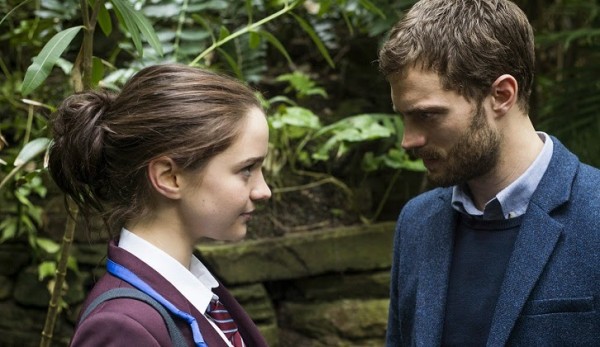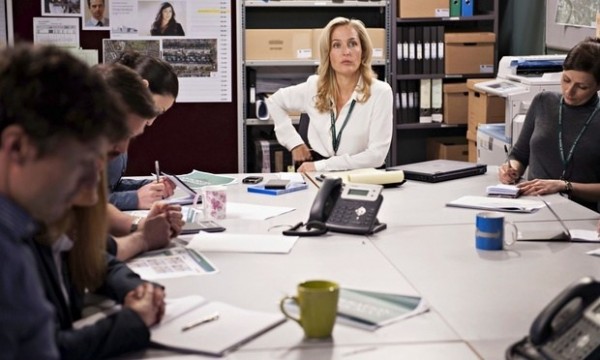
Courtesy of BBC 2 / Netflix
One of the strongest criminal series in recent memory returns for a second round. How does this series stack up against the first?
Let’s bitch it out…
Two years ago Netflix acquired a BBC 2 series called The Fall. The first series – clocking in at a scant five episodes – was a brilliant crime saga documenting the crimes of a violent criminal and the cool as ice Detective Inspector pursuing him. I was absolutely enamoured with it, awarding it my second best TV series of 2013.
Series one ended on a cliffhanger as serial murderer and sadist Paul Spector (Jamie Dornan) placed a taunting call to his nemesis, DI Stella Gibson (Gillian Anderson). After five hours of cat and mouse games between predator and prey, the series came to a close as Stella closed in on Paul following his failed murder attempt of victim Annie Brawley (Karen Hassan). And he just…walked away.
Series two picks up ten days later. Spector has run away to Scotland with his unsuspecting wife, Sally Ann (Bronagh Waugh) and their children under the guise of repairing their broken marriage (he previously confessed to a relationship with their fifteen year old babysitter, Aisling Franciosi’s Katie Benedetto). Meanwhile back in Belfast Stella’s task force has grown, but the investigation is spinning its wheels. Adding to the problem: her personal life ends up splashed across the front page after she is romantically linked to the married police officer gunned down in the first series. Unsettling both adversaries is a promising place to start back up and things escalate when Stella leaks details that only Rose Stagg (Valene Kane) – a cold case from Spector’s past – could know. The act inadvertently lures Paul back to Belfast to tie up loose ends and the game begins anew.
One of those loose ends is Katie, whose actions throughout the second series highlight both the show’s strengths and weaknesses. In the first go-around Katie was a teen infatuated with a dangerous married man; her fixation led to one of series one’s most shocking incidents when Paul attacked and overpowered her in the family home after she found a lock of woman’s hair in his study. Their dangerous entanglement continues immediately after he returns; the young girl seeks him out and, despite mounting evidence of his guilt, her fascination and <gulp> sexual interest in him increases.Throughout the six episodes their interactions provide The Fall‘s most provocative moments, but even the most casual viewer will find the shallow examination of their power dynamic and sexual politics problematic.

Courtesy of BBC 2 / Netflix
And therein lies the issue with the second series. Creator Allan Cubitt opted to take over the writing reins for the entire season and the result is flashes of brilliance mired in inconsistency. The acting, particularly the leads, remains top tier, but the characterizations are shaky. Outside of Stella and Paul, individuals act inconsistently (John Lynch’s Jim) or unrealistically (Katie). Storylines are arbitrarily picked up and dropped on an as-needed basis, which is welcome when it comes to Jim’s corruption scandal, and less so when it comes to the domestic abuse case Paul worked on in series one. The latter is the most egregious example of Cubitt’s cluttered approach to structuring the series: SPOILER a long-dormant storyline shouldn’t be the narrative lynchpin required to produce a groan-worthy cliffhanger that exists solely to garner a third series END SPOILER.
Whatever faults lie with The Fall are traceable directly back to Cubitt. His propensity for semi-glacial pacing and arbitrary subplots come at the expense of pathologist Reed Smith (Archie Panjabi) and street cop Danielle Ferrington (Niamh McGrady) – characters who helped give the first series its feminist perspective. The decision to sideline strong, interesting women in favour of dull, milquetoast men such as Glen Martin (In The Flesh‘s Emmett Scanlan) is questionable. At its core, however, the show remains compulsively watchable – thanks primarily to the dedication of leads Anderson and Dornan. While the show around them may not be constructed and paced quite as well as it was in the first series, the pair and their macabre dance for power and dominance is enthralling. Their inevitable face-to-face meeting proves to be everything I hoped for and ranks among the best 14 minutes of TV I’ve seen in some time. I was especially fond of the way that the scene is shot, in extreme close-ups that emphasize the depraved intimacy and shifts of power between prey and predator, man and woman.
Male aggression, fantasy and power – social, political and sexual – remain thematic interests of Cubitt’s and The Fall still has a myriad of things to say on the (literal) battle of the sexes. At one point late in the series a new character, Thomas Anderson (Colin Morgan) – who seems purposefully groomed to bear an uncanny resemblance to Spector – asks about Stella’s fascination with the serial killer. Her response undercuts the entire scenario; rather than rising to the inherent sexism that she may be attracted to the man she has spent so much time trying to capture she cites a study that asked men and women about their fears of the opposite sex. Speaking in her slow, chilled cadence, Stella elaborates on the findings: “Men are afraid that women will laugh at them. [Pause] Women are afraid men will kill them.” And then: “He [Spector] might fascinate you…I despise him with every fibre of my being.”
It’s incredibly powerful, and – as delivered by Anderson – representative of the brilliance of the series when it hits its mark. I only wish there were a few more moments like this in The Fall‘s ambitious, but muddled second series. Perhaps Cubitt will have a chance to make right by his characters and their wonderful portrayers; he’s currently campaigning for a third series. So far it’s unclear if this is the last we’ll see of the series but I, for one, would be sad if this is the end of Stella and Paul. Series two may have its problems, but I would gladly watch a third round between those two. Here’s hoping we get the chance.
The Fall is available in its entirety on Netflix on Friday, Jan 16.